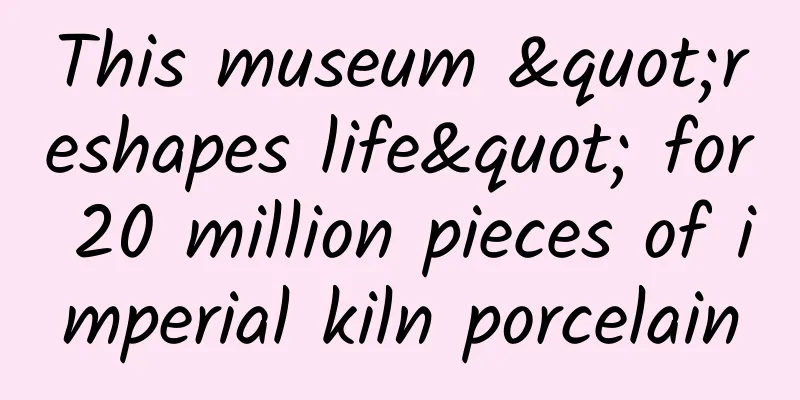This museum "reshapes life" for 20 million pieces of imperial kiln porcelain

|
During the Qingming Festival holiday, a total of 50,207 tourists visited the Jingdezhen Imperial Kiln Museum. The museum is located in Jingdezhen, Jiangxi Province, adjacent to the Ming and Qing Imperial Kiln Site. The exhibition in the museum focuses on the nearly 600-year history of the Ming and Qing Imperial Kilns, and displays more than 800 pieces (sets) of important cultural relics unearthed from the Imperial Kiln Site. Nearly 100 tons of porcelain fragments were unearthed from the Imperial Kiln Site. Jingdezhen, which was named after porcelain, prospered because of porcelain, and was established because of porcelain, has a history of more than 2,000 years of pottery making, more than 1,000 years of official kiln history, and more than 600 years of imperial kiln history. Jingdezhen porcelain is famous for being "white as jade, bright as a mirror, thin as paper, and sounding like a chime". The porcelain fired in the imperial kilns of the Ming and Qing dynasties represented the highest level of porcelain production at that time. The firing process of the imperial kiln was very complicated, and the quality rate was low. In order to prevent the products from flowing into the private sector, defective or rejected products were broken up and buried together. Over the years, archaeologists have excavated the site of the imperial kiln, and nearly 100 tons of imperial kiln porcelain fragments have been unearthed. Since the 1980s, porcelain fragments from the Hongwu, Yongle and Xuande periods of the Ming Dynasty have been unearthed one after another. After 2014, a large number of imperial kiln porcelain fragments from the so-called "blank period" (Zhengtong, Jingtai and Tianshun periods of the Ming Dynasty) were discovered at the northern foot of Zhushan Mountain. After continuous field archaeology and artifact sorting, archaeologists also discovered for the first time the remains and relics of workshops, porcelain clay raw materials, glazes, semi-finished products, etc. that fully reflect the production of overglaze colors in the official kilns of the Ming Dynasty, filling the gap in my country's ceramic craft archaeology. Today, these porcelain fragments have been "rediscovered" through archaeological methods. Nearly 20 million pieces of broken porcelain have been made into specimens and included in the Jingdezhen ancient ceramic gene bank, or restored into complete porcelain, becoming the main exhibits of the Jingdezhen Imperial Kiln Museum. It is these fragments that have revealed the firing process and raw material formula of ancient ceramics, and their value is no less than that of the handed-down collections of the same period. A restored Ming Dynasty blue-and-white dragon-patterned jar and its fragments in the Imperial Kiln Museum in Jingdezhen, Jiangxi (Photo provided by the author) Technology gives porcelain tiles "new life" The application of modern science and technology in the field of porcelain restoration and research is becoming increasingly close. The Imperial Kiln Museum has established a Raman spectroscopy room and a fluorescence analysis room for detecting objects. Compared with complete objects, ancient ceramic fragments are more suitable for detection technology. With the help of instruments such as energy spectrum electron microscopes and Raman spectrometers, researchers can observe the surface patterns of porcelain pieces, splice and restore the shape of the object, slice to understand the embryo, grind and analyze materials, and even study the firing temperature. For example, in the analysis of blue-and-white porcelain pigments, domestic academic circles have previously speculated that blue-and-white porcelain from the Yongle and Xuande periods of the Ming Dynasty used both imported pigments and domestic raw materials through Qing Dynasty literature and circulated craftsmanship, but the accuracy is questionable. Now, researchers have analyzed blue-and-white porcelain fragments using a focused ion beam microscope and confirmed that both domestic and imported raw materials were used. In the ancient ceramic gene bank, researchers can obtain gene fragment information such as "archaeological information fragments", "body material technology fragments", and "molding technology fragments". This information can not only be used for display, cultural relics protection and 3D printing models, but also provide technical support for the development of cultural and creative products and the construction of digital museums. In 2023, the ancient ceramic genetic specimen robotic flexible sample preparation system was officially launched. This is my country's first robot used in the preparation of cultural relics genetic specimens. It can help researchers process and prepare ancient ceramic genetic specimens more accurately and efficiently. With the help of technology, more and more broken porcelain pieces are now reborn, telling the world the historical stories of the imperial kilns of the Ming and Qing dynasties. (The author is a research intern at the Exhibition Design Center of the China Science and Technology Museum) |
<<: Bees train themselves to become "engineers"
>>: Pregnancy will make people stupid for three years. Anesthesia: I won’t take the blame for this!
Recommend
Can Microsoft Surface 3 compete with Apple iPad to the end?
The Surface series has been around for so long. I...
WeChat’s turnaround is harder than an elephant
Zhang Xiaolong, the "Father of WeChat",...
Chats can be encrypted! Tencent launches WeChat message encryption app "MiXin"
Recently, Tencent launched a mini program called ...
This small hole on the ear is not a symbol of "wealth"! It may be a dangerous hole...
This article was reviewed by: Xiaobo Zhou, Doctor...
Introduction to iQIYI’s effective promotion products
There is no doubt that iQiyi has taken the top sp...
There are “tricks” to making popular products, here are the creative secrets for Internet finance advertising!
In the attention economy, high-quality creativity...
This seasonal rose-colored sea of flowers is actually called Pig
I still remember that it was the end of April, th...
Three tips for SMS push elements based on the 5W2H method
Here is a summary first. Please scroll to the bot...
If you drink 2 taels of liquor every day, what will your body look like in 10 years?
Many people are not unfamiliar with alcohol. They...
Afraid of losing control of blood sugar and afraid to eat staple food? Take this staple food-friendly recipe, which is both sugar-controlling and delicious
I have diabetes One of the most painful things Do...
The room for price increase of China's home appliances from the crazy rise of Moutai
In recent times, the skyrocketing prices of a num...
How to operate your Zhihu? Just read this article!
Whether from the perspective of user growth or us...
Tianfu Chengdu students qt tea tasting arrangement tea drinking at night
Chengdu student tea tasting appointment arrangeme...
Case: Why McDonald's and KFC are always opened next to each other
First, let me tell you a story: There was a pair ...









